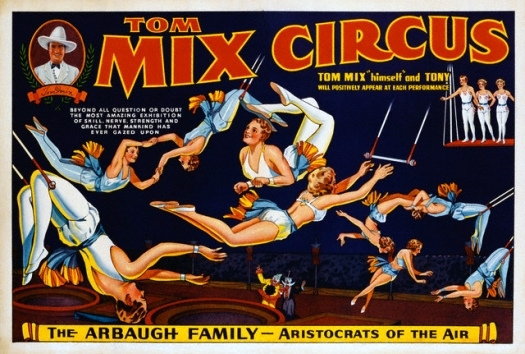Tom Mix: the original John Wayne
Ever look at John Wayne's confident strut and ten gallon hat and stop to consider just how iconic and charismatic this man was? Whether you like him or not, John Wayne represents a whole era of lone rangers and machismo of the old west - and that is why he is rightfully considered a cultural icon. Nevertheless, it is becming a worryingly inscreasing unknown fact that, while he is possibly the ultimate incarnation of the cowboy ala Americana, he was not the first and he too was greatly influenced in building an image by a great megastar that is being largely and unrightfully forgotten but who was hugely popular in the silent film days.
His name was Tom Mix.
Born Thomas Hezikiah Mix on the 6th of January 1880, he was an american star of many popular westerns and between 1909 and 1935, he appeared in 291 films - although some sources claim he made almost 400! Practically all of them are sadly lost - in fact Wikipedia quotes that only nine of them have survived to this day.
Much like many other stars of the silent film (Theda Bara was another drastic example), his true identity was kept somewhat of a mystery by agents, producers and distributors who were afraid their star's personalities would outshadows their show one. Officially, in press releases, Mix was billed as being born in Texas, and as being a former fighter in numerous war such as the Boxer Rebellion and the Spanish-American War as well as having been a sheriff in Kansas, a US marshal in Oklahoma and a Texas Ranger. However, in reality, he was born in Pennsylvania, deserted the Army in 1902 and was a drum major in the Oklahoma Territorial Calvary band when he went to Hollywoood.
At the peak of his career, he was the highest paid actor in Hollywood, earning the equivalent of over 200,000 dollars a week. He started off as a cast memeber at the Selig Polyscope Company, which was an American motion picture company that launched the careers of other popular stars of early cinema from Harold Lloyd to Roscoe "Fatty" Arbuckle (and ended film production in 1918, after which it became a struggling zoo attraction). After a number of supporting roles, the first of which was titled The Cowboy Millionaire and was released in October 1909, a year later he appeared as "himself" in a short documentary film titled Ranch Life in the Great Southwest, in which he portrayed his skills as a cattle wrangler. The film was a huge success and after at least hundred more films for Selig, he signed with the Fox Film Corporation.
His popularity was so big that Fox decided to build a whole shooting set for him, named Mixville - which was a 12 acre vast set that was, in all effect, an almost perfectly running town of the Old West, and included an old Indian village and even a simulated desert! He was so popular that his horse Tony became a celebrity too. He became so important that he was a pallbearer at the funeral of Wyatt Earp.

Admittedly, it was no mystery that Tom was not much of an actor. Indeed, he liked fast paced action sequences and little of the outlining interactions between characters. As a result, when it came time to make a transition to sound, this became clearer. But the prime reason as to why he quit acting is considered to have been his injuries - in true action star fashion, he did all his own stunts.
Mix's last screen appearancewas a 15-episode sound Mascot Pictures serial called The Miracle Rider, in which Mix tries to save an Indian tribe from an evil rancher and oil company owner. The film was released in 1935, he was 55 years old and despite the money his career had rolling in, much like another countless numbers of early cinema stars, his savings were wiped out as a result of a life of boozing, women and vice. But he was able to reinvent himself in a career as a circus artist.
He died on a car crash 1940. He was driving too fast and never read the signs about construction barriers at an upcoming bridge. The crash caused an alluminium case he was carrying, in which he held a considerable amount of money and other valuables. The case flew forward and landed on his head - the force of the impact broke his neck instantly. The funeral was attended by thousands of friends and fans.
His star would soon after be replaced and outshone by the the successive myth of John Wayne. Tom Mix belongs to a time when films were much too intense and fast to connect with the audience in any significant way. Most of his films, much like Larry Semon's slapsticks, are conglomerations of stunts with wafer thin plots. But it was his charisma that made them come alive. He is the image of an era of pioneering - the beginning of cinema stars becoming role models of popularity and success. Icons of eager and violent escapism - a beloved icon of bravery, looks an personality that belongs to an American incarnation that sought to give itself a flashy international identity through the birth of a new art.